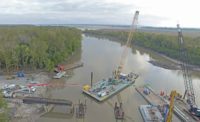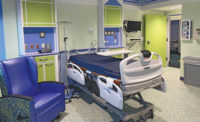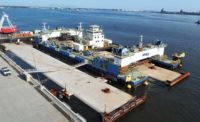The Foundry
Kalamazoo, Mich.
Award of Merit
Owner: Treystar
Construction Manager: CSM Group
Lead Design Firm: Eckert Wordell
Structural Engineer: OIK Industries
Civil Engineer: OIK Industries
MEP Engineer: Buist Electric/Mall City Mechanical
In delivering the 52,000-sq-ft Foundry project, the design and construction team not only honored the site’s former use as an iron foundry, it also recycled and repurposed many structures and materials.
“I love to build new buildings, but being able to repurpose the structure and work with the developer to identify the value of the existing structure was very rewarding,” says Todd McDonald, principal and COO of construction manager CSM Group.
Crews demolished most of the interior of the original two-story 6,000-sq-ft brick foundry, which was built in 1907. Interiors of an attached 47,000-sq-ft former steel fabricating plant were also demolished. A 30,000-sq-ft rear section of the building was entirely demolished.
All iron components were sent to a local recycling facility to reduce debris being sent to landfills. Onsite concrete—such as old foundations and buried concrete—was crushed and recycled for use in construction of the new facility. Asphalt that was on site was salvaged, ground up and repurposed into the base of the new parking lot. An existing foundation along Portage Creek was retained to minimize excavation along the bank.
Although the project didn’t seek any green certifications, McDonald says it made financial sense to use sustainable practices and materials.
“You recycle and you use green products because it’s the right thing to do, not to get a certification,” he says.
Due to the highly contaminated soils found on site, the team coordinated with the city of Kalamazoo’s Brownfield Redevelopment Authority and the Michigan Dept. of Environmental Quality. CSM Group worked closely with site contractors to ensure that infrastructure was installed in a manner that would meet regulations and keep workers safe from contamination.
To improve safety, CSM Group focused its training programs on site-specific hazards, including contaminated soils that were discovered on the brownfield site. From its origins as an iron foundry, lead, asbestos and silica were present. As a result, specialty training was required for all project team members, including subcontractors. CSM claims that training focused on project-specific hazards is more effective than a “shotgun approach” to training, which covers all possibilities of encountered hazards at a high level.
The completed office building’s layout is based on a concept of open and collaborative spaces. Its core areas, which are shared by all tenants, are set up with small workspaces. The building includes onsite dining to create a campus-like feeling.







Post a comment to this article
Report Abusive Comment